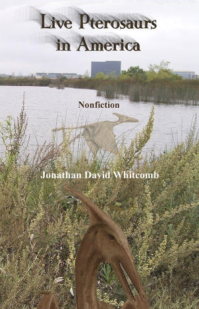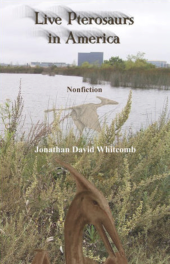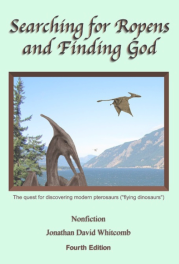

Live Pterosaurs
Commonly called “pterodactyls”
Many of the eyewitness reports come from the southwest Pacific,
including Papua New Guinea, Australia, and Indonesia; but some
come from Africa, South America, North America, and Europe.
Living pterosaurs, or flying creatures that appear so to be, have
been observed all over the world, obviously non-extinct. The type
with a long tail is called ropen, the name some of the villagers of
Umboi, Papua New Guinea, call the nocturnal flying creature of
their island. (“Ropen” comes from the Kovai language.)
Apparently these featherless flying
creatures, mostly with long tails,
live in many areas of the planet





copyright 2010-2019 Jonathan Whitcomb

Photograph by Joe Le Merou (Flight from Bali, Indonesia) http://creativecommons.org/licenses/by/4.0/legalcode
Pterosaur in Indonesia
In June of 2008, an English captain and Australian first officer, both former navy
pilots, were flying a small twin-engined plane near the end of a 700-mile flight
from Broome, Australia, to Bali, Indonesia, when the captain saw what appeared
to be another plane approaching on a collision course. Yet he soon saw that it
was no plane but a huge flying creature.
The captain put his plane into a dive, distracting the first officer from the map,
but the creature also went into a dive. A quick bank of the plane avoided the
collision, as the non-plane passed by the window. Both men came up with the
same word: “pterodactyl.”
Details about this report of an apparent pterosaur that nearly collided with a
small plane can be found in the nonfiction book Searching for Ropens and
Finding God, by Jonathan Whitcomb (fourth edition, pages 35-37).
This sighting off the coast of Indonesia, in 2008, needs to be taken in context:
Many eyewitnesses have seen apparent living pterosaurs in the southwest
Pacific, and these include local natives, Americans, and Australians.
Pterosaurs Living in Ohio
According to the book Live Pterosaurs in America, by Jonathan
Whitcomb, one eyewitness answered the following questions:
Q: Was there anything unusual about the tail?
Answer: . . . it was long and skinny, it also had a spade on it about
3 or 4 inches from the very end
Q: [were there any] feathers?
Answer: Absolutely no feathers
Jonathan Whitcomb also got an email with this:
“. . . Several years ago when I was in college I briefly saw what looked
like two of them flying close together . . . while I was driving. I thought
I was crazy for a minute, like I was seeing things . . . but I don't know
of any birds that look like that . . . featherless, that large, and gray. I
live in Marietta, Ohio, and this was maybe 8-10 years ago. Whatever
they were, they were awesome to see but I must admit that I was happy
to be inside my car.”


Pterosaur Sighting in Minnesota
“In 1995 I had a very close encounter [in southern Minnesota] with some-
thing similar to a pterosaur. . . . I headed down to ‘my’ fishing spot. . . . It
was dusk by the time I decided to head back home . . . . an outcropping
or a cave (. . . either a shallow cave or a deep outcropping) as I got near
it I heard something . . . like clicking or tapping . . .
“I got within 15 feet of the mouth of the cave. I see this beautiful burgundy
[colored] thing standing near the opening [of the cave]. It was smooth with
no feathers, and a large horn out of the back of it's head. I could see that,
as it was pulling meat off of a fish, its beak was making the tapping noise
I heard. I, being a complete idiot . . . decided to see how close I could get
to it . . . It turned around and stared right at me. I was transfixed . . . [It]
walked a little ways back in the cave ran forwards and flew off. That's
when I got a good look at it in flight.
The tail was about 1/3- 1/2 of it's wingspan [with] a point similar to a
diamond on a playing card. It's wings were huge . . . 19-20 foot wingspan
. . . I never went back to that area again. . . .”
Live Pterosaurs in America
Searching for Ropens
and Finding God
A modern pterosaur observed in eastern Cuba in 1965 and
sketched by the eyewitness years later: a flying “dinosaur”
For decades, many persons assumed that this photograph must be a hoax, for
some photographers in the mid-19th century did manufacture fake photos, and
it has long been common knowledge that Western scientists have long declared
that all dinosaurs and pterosaurs became extinct long ago. From early 2017 to
late 2018, two scientists became convinced that this was a genuine image of a
living pterosaur. Since late 2018, however, this has been thrown into doubt.
These two scientists (Jonathan Whitcomb on left; Clifford Paiva on
right) have declared that the video footage obtained by Paul Nation
deep in the interior of the mainland of Papua New Guinea , in 2006,
was most likely of the bioluminescence of two flying creatures.
This sketch of two “pterodactyls” was drawn by the eyewitness, U.S. Marine
Eskin Kuhn, a few minutes after he observed the two flying creatures near
the coast at Guantanamo Bay, Cuba, in 1971, at close range and in clear
daylight. He has maintained the reality of his encounter from that day until
the present, in spite of occasional skeptical remarks from some persons.
The American explorer and nonfiction writer
David Woetzel has participated in expeditions
in search of living dinosaurs and pterosaurs.
His searching has been done in Africa, Papua
New Guinea, North America, and elsewhere.
He is not alone: Other Americans who have
searched for living pterosaurs in various areas
of the planet include Paul Nation, Jonathan
Whitcomb, and Garth Guessman.






Live Pterosaurs
Commonly called “pterodactyls”
Many of the eyewitness reports come from the south-
west Pacific, including Papua New Guinea, Australia,
and Indonesia; but some come from Africa, South
America, North America, and Europe.
Living pterosaurs, or flying creatures that appear so
to be, have been observed all over the world, obviously
non-extinct. The type with a long tail is called *ropen,
the name some of the villagers of Umboi, Papua New
Guinea, call the nocturnal flying creature of their
island. *(from the Kovai language)

Photograph by Joe Le Merou (Flight from Bali, Indonesia)
http://creativecommons.org/licenses/by/4.0/legalcode
Pterosaur in Indonesia
In June of 2008, an English captain and Australian first officer,
both former navy pilots, were flying a small twin-engined plane
near the end of a 700-mile flight from Broome, Australia, to Bali,
Indonesia, when the captain saw what appeared to be another
plane approaching on a collision course. Yet he soon saw that
it was no plane but a huge flying creature.
The captain put his plane into a dive, distracting the first officer
from the map; the creature also went into a dive. A quick bank
of the plane avoided the collision, as the non-plane passed by
the window. Both men came up with the word “pterodactyl.”
Details about this report of an apparent pterosaur that nearly
collided with a small plane can be found in the nonfiction book
Searching for Ropens and Finding God, by Jonathan Whitcomb
(fourth edition, pages 35-37).
This sighting off the coast of Indonesia, in 2008, needs to be
taken in context: Many eyewitnesses have seen apparent living
pterosaurs in the southwest Pacific, and these include local
natives, Americans, and Australians.


Live Pterosaurs in America
Searching for Ropens
and Finding God
Pterosaurs Living in Ohio
According to the book Live Pterosaurs in America, by Jonathan
Whitcomb, one eyewitness answered the following questions:
Q: Was there anything unusual about the tail?
Answer: . . . it was long and skinny, it also had a spade on it
about 3 or 4 inches from the very end
Q: [were there any] feathers?
Answer: Absolutely no feathers
Jonathan Whitcomb also got an email with this:
“. . . Several years ago when I was in college I briefly saw
what looked like two of them flying close together . . . while I
was driving. I thought I was crazy for a minute, like I was see-
ing things . . . but I don't know of any birds that look like that . . .
featherless, that large, and gray. I live in Marietta, Ohio, and
this was maybe 8-10 years ago. Whatever they were, they
were awesome to see but I must admit that I was happy to
be inside my car.”

A modern pterosaur observed in eastern Cuba in 1965 and
sketched by the eyewitness years later: a flying “dinosaur”
Pterosaur Sighting: Minnesota
“In 1995 I had a very close encounter [in southern Minnesota]
with something similar to a pterosaur. . . . I headed down to
‘my’ fishing spot. . . . It was dusk by the time I decided to head
back home . . . . an outcropping or a cave (. . . either a shallow
cave or a deep outcropping) as I got near it I heard something
. . . like clicking or tapping . . .
“I got within 15 feet of the mouth of the cave. I see this beauti-
ful burgundy [colored] thing standing near the opening [of the
cave]. It was smooth with no feathers, and a large horn out of
the back of it's head. I could see that, as it was pulling meat
off of a fish, its beak was making the tapping noise I heard. I,
being a complete idiot . . . decided to see how close I could
get to it . . . It turned around and stared right at me. I was
transfixed . . . [It] walked a little ways back in the cave ran for-
wards and flew off. That's when I got a good look at it in flight.
The tail was about 1/3- 1/2 of it's wingspan [with] a point
similar to a diamond on a playing card. It's wings were huge
. . . 19-20 foot wingspan . . . I never went back [there] . . .”
copyright 2010-2019 Jonathan Whitcomb




This sketch of two “pterodactyls” was drawn by the eyewitness,
U.S. Marine Eskin Kuhn, a few minutes after he observed the
two flying creatures near the coast at Guantanamo Bay, Cuba,
in 1971, at close range and in clear daylight. He has maintained
the reality of his encounter from that day until the present, in
spite of occasional skeptical remarks from some persons.

The American explorer and nonfiction writer
David Woetzel has participated in expeditions
in search of living dinosaurs and pterosaurs.
His searching has been done in Africa, Papua
New Guinea, North America, and elsewhere.
He is not alone: Other Americans who have
searched for living pterosaurs in various areas
of the planet include Paul Nation, Jonathan
Whitcomb, and Garth Guessman.



These two scientists (Jonathan Whitcomb on left; Clifford Paiva on
right) have declared that the video footage obtained by Paul Nation
deep in the interior of the mainland of Papua New Guinea , in 2006,
was most likely of the bioluminescence of two flying creatures.
For decades, many persons assumed that this photograph
must be a hoax, for some photographers in the mid-19th
century did manufacture fake photos, and Western scientists
have long declared that all dinosaurs and pterosaurs became
extinct long ago. From early 2017 to late 2018, two scientists
became convinced that this was a genuine image of a living
pterosaur. Since late 2018, however, this has been thrown
into doubt.
